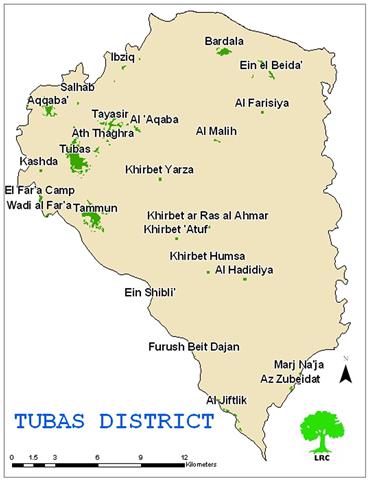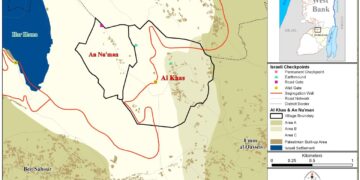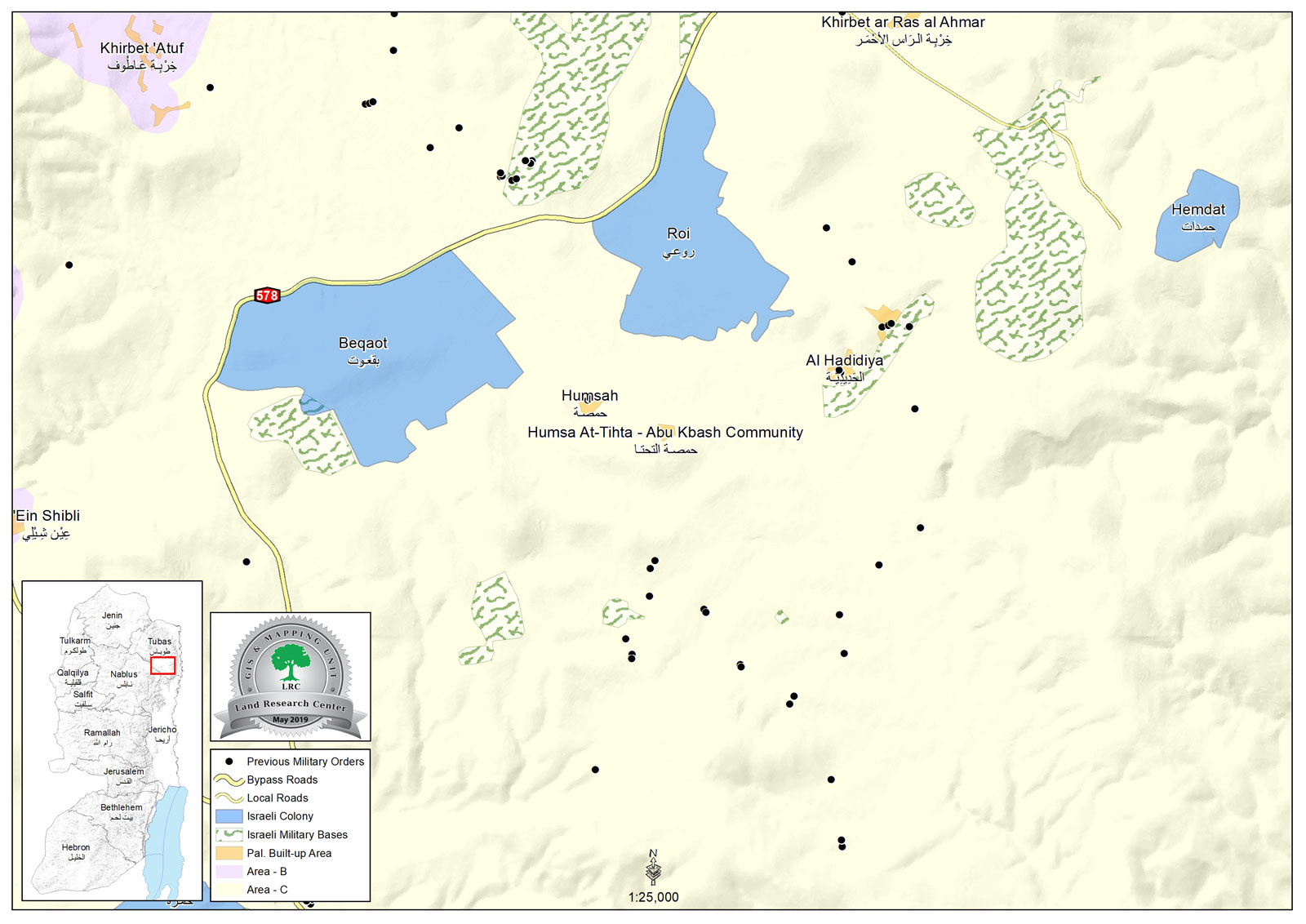Last July the Israeli occupation authorities informed the villagers of Al Hadidiay and Humsa villages in Tubas governorate of the supreme court's decision to dismiss them out of the area under the pretext that they didn't have any permissions to settle in that particular area. On August 7th, 2007, the Israeli army military command in Jordan valley issued a military order stipulating the eviction of all families in Al Hadidiya and Humsa by force after allocating the target area as a closed military zone.
(Map 1: location of Al Hididiya and Humsa)
The Israeli supreme court's decision came in response to several memoranda submitted by the army and Israeli planning and construction personnel allegedly claiming that the villagers recently began to build permanent housing, an accusation flatly denied by the local people who confirmed that all the dwellings are of primitive nature built of animal hair tents and barracks which are very easy to dismantle at any time.
(Photo 1: Al Hadidiya, Tubas: some of the threatened tents and barracks which
are considered permanent housing by the occupation authorities).
Photo courtesy of LRC
A history of repeated displacement
The population of Al Hadidiya and Humsa derived from the families of Basharat and Bani Odeh from Tamun village to the east of Tubas city. Before the occupation of 1967, a portion of Tamun people moved to settle in a place called Al Hadidiya in the Buqei'a valley which is about 10 km to the eat of Tubas, and began to rear animal due to the availability of rich soil, pastures and water.
In September, 2002, about 320, the whole population of Al Hadidiya were taken at surprise by the Israeli occupation army who destroyed all their dwellings before kicking them out of Al Hadidiya. Determined to stay, they moved to another location not far from Al Hadidiaya where they pitched their tents. However, in November, 2002, the occupation army returned with their bulldozers and wiped them out of the area. This time they moved to settle in Humsa which is 1.5 km from Al Hadidiya, and even, some of them returned to Al Hadiidya itself. As soon as they get there, they presented an appeal to the Israeli supreme court demanding that the destruction and eviction campaigns against them should be terminated. In reply, the supreme court issued a decision confining them to stay in 91 dunums which are un enough for the livelihood of their cattle whose number is estimated at 10000. The occupation authorities even asked the stricken community to get the area surveyed and forced them to pay for the surveyor's expenses which were costly.
(Photo 2: Al Hadidiya, Tubas: a citizen showing handbag full of documentation
paper prepared during law case at Israeli supreme court ) … Photo courtesy of LRC
Increasing harassment
The Israeli army along with settlers continued to attack and harass the local people by beating or punishing them, confiscating their cattle and depriving them from accessing into water sources in the area. The latest violations took place on July 28, 2007, when the Israeli army confiscated a tractor (one of only two in the village) and water tank from a villagernamed Ahmad Abdallah Bani Odeh from Humsa, worsening the already dire water shortage in the village.
Mr. Bani Odeh's tractor and water tank confiscated at the Hamra military checkpoint as he was going to ‘Ain Shibli, a few km southwest from his home in Humsa, to fill the water tank for his village. Palestinians living in Hadidiya and Humsa have to travel to other areas to buy water, although there is a well nearby. The Israeli army does not allow them, even if they pay, to use this well, which is for the sole use of the Israeli settlers in the nearby colonies of Ro’i, Beka’ot and Hemdat.
The Israeli army has told the villagers that to get the tractor and water tank back they must pay a fine of 4,500 Shekels (approx US$1,000), unaffordable for people living below the poverty line (less than US$2 a day), and must sign a pledge to leave and not return to the area, which the Israeli army considers a “closed military zone” for use by Israeli forces as a shooting practice area.
(Photo 3: one of only two water tanks in the village)
Photo courtesy of LRC
The confiscation of the water tank is part of the Israeli army's increasing efforts to force the Palestinian inhabitants of large areas of the Jordan Valley to leave their villages. The existing wells are being used by Israeli settlers and are barred to the local Palestinian population; Palestinians are not allowed to drill new wells. The increased restrictions on their movements have made it even more difficult for them to bring water from other areas, ultimately threatening their survival in the area.
Israeli colonies in the area
The following is a list of Israeli colonies near the Al Hadidiya and Humsa villages:
|
Colony name |
Date of establishment |
Population In 2005 |
Municipal area |
Built up area |
|
Ro'i |
1978 |
117 |
3008 |
134 |
|
Beqa'ot |
1972 |
156 |
2801 |
120 |
|
Hemdat |
1980 |
140 |
700 |
82 |
|
Total |
413 |
6509 |
336 |
|
BACKGROUND INFORMATION
The Israeli army is making increasing efforts to force local Palestinian communities out of the area, notably through house demolition, restriction on movement and preventing access to water and other essential services. These communities have been living in the areas since long before the Israeli army occupied the West Bank in 1967.
The Palestinian Bedouin residents of Hadidiya have traditionally been farmers and herders, living off their crops and the dairy products from their sheep and goats. The growing restrictions imposed by the Israeli army in recent years on their movements and access to water have made it increasingly difficult for them to survive in the area. Now the Israeli army is taking steps to force them out of the area altogether.
The villagers have welcomed international pressure, which has brought several high-level delegations to visit the Hadidiya and Humsa area. However, as international attention diminishes the threat to the villagers increases and further action now is crucial.
For years Israel has pursued a policy of discriminatory house demolition, allowing scores of Israeli settlements, illegal under international law, to be built on occupied Palestinian land, while confiscating Palestinian lands, refusing building permits for Palestinians and destroying their homes. The land vacated has often been used to build illegal Israeli colonies. International law forbids occupying powers from settling their own citizens in the territories they occupy.
Palestinians, especially Palestinian villagers, who live in the Jordan Valley, have suffered particular pressure. Most of the Jordan Valley area of the occupied West Bank has been declared a military area by the Israeli army or has been taken over by some 36 Israeli colonies.
Prepared by
The Land Research Center
LRC


















